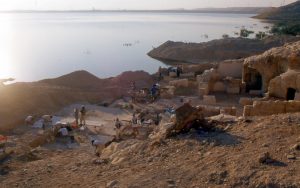Introduction
In May of 2000, the New York Times published a cry of alarm for the Roman city of Zeugma, in southeast Anatolia, Turkey. It was soon to be submerged by the waters of the Euphrates, because a new dam was being built downstream. The ancient city of Zeugma was founded by Seleucus in 312-281 BC at the place where a bridge over the Euphrates provided a commercial route to the Orient. The city, an early Roman conquest, was marked by great wealth linked to its commercial fortunes, as demonstrated by the high quality of the mosaics, frescoes and objects found there.
The New York Times appeal was taken to heart by David Packard of the Packard Humanities Institute (PHI) of California, who asked Richard Hodges of the University of West Anglia, UK, and Roberto Nardi to undertake a fact-finding mission to the site and develop an action plan. Fifteen days later, a group of 25 conservators and 120 English, French and Turkish archaeologists were on site, ready to implement the plan developed by conservators and archaeologists and approved by the Turkish Ministry of Culture. This plan — the Zeugma Archaeological Project (ZAP 2000) — was based on a “targeted” archaeological investigation and a proposal for conservation in situ. It was a wide-ranging emergency operation aimed to collect topographical information on the city and protect the finds before the water, pouring in at 20 cm a day, submerged the so-called “Area B”, which was about 30% of the city.
Activities implemented during the conservation program were as follows: assistance to the archaeologists during the excavation and providing safe excavation; stabilization and recovery of movable finds; documentation through rubbings of inscriptions and graffiti; preventive conservation; consolidation in situ and protection with a sacrificial layer over elements such as mosaics, wall paintings and plasters; detachment and removal of mosaics at risk and/or judged “exceptional”; planning and management of the reburial program for excavated areas; control and maintenance of the fluctuating water level. In all, 4000 finds and 160 m2 of surfaces were removed from the site, 8700 m2 of archaeological structures were reburied using 10,500 m3 of sand, pebbles and stones — some 630 truckloads.
Under extreme climatic conditions, the conservators worked on site for six months before the Euphrates waters, reaching their maximum level, defined the new panorama of Zeugma, which is now a national archaeological park.





















